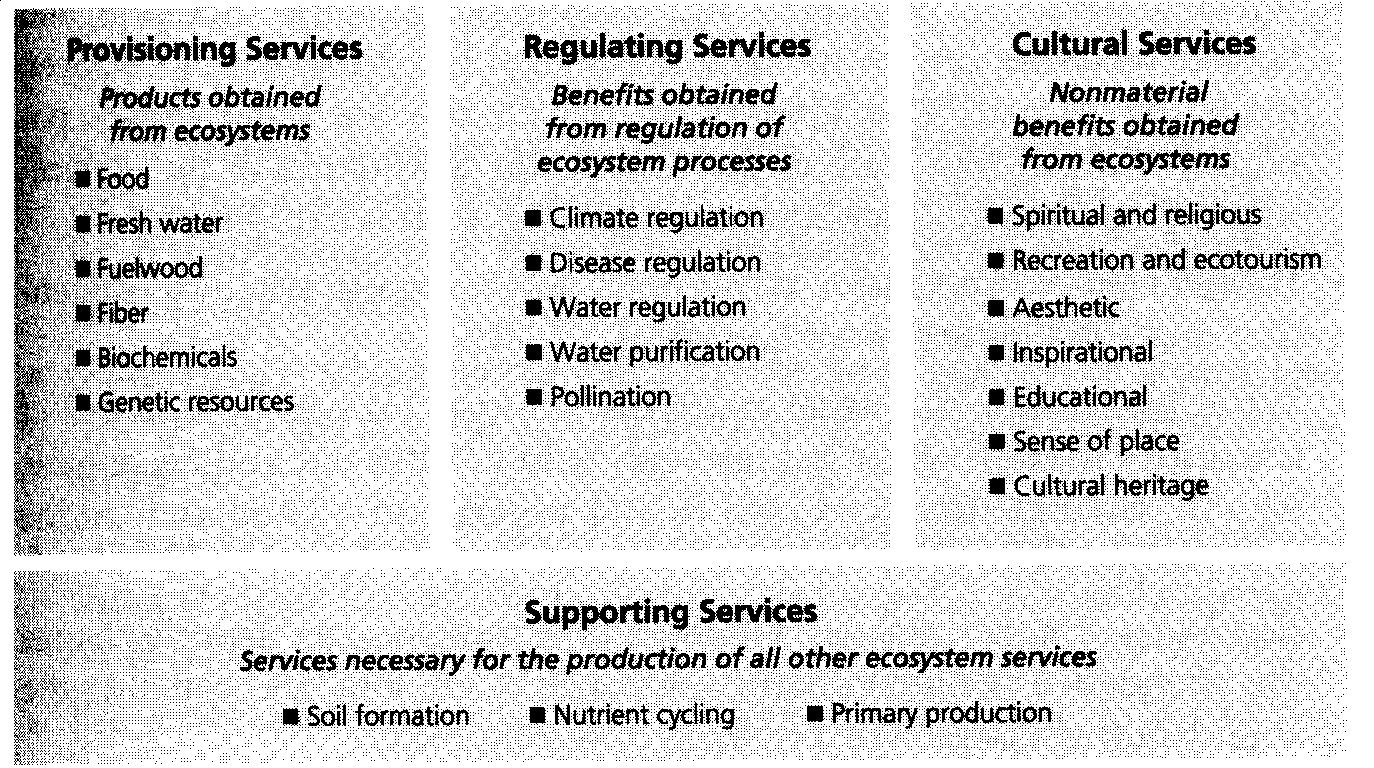|
- Provisioning Services – which provide resources used in production (timber, fish, etc.)
- Regulating Services – which regulate ecosystem processes, such as decompositing organic wastes, cleansing of the air (by oxidation, etc.)
- Cultural Services -providing benefits of a spiritual, aesthetic, recreational or psychological nature; giving meaning to place, etc
- Supporting Services - which regulate processes necessary for all the other ecosystem services.

|
|
|
Resource Extraction Destroyes Ecosystem Services
This distinction between the resource ( stock) and service ( fund) functions of the same ecosystem is a key concept in understanding the relationship between the physical size of the economy and the ecosystem's capacity to support life. The same ecosystem provides both resources and services as forms of natural income. But only resource extraction, which generates large amounts of material throughputs, is identified in economic theory and practice. Lumber has a market price; erosion control or microclimate impact from the same forest likely do not. Consequently, most policy focus is on lumber production rather than on the full range of natural income provided by ecosystem services. It is the magnitude and pervasiveness of these ecosystem service losses, rather than resource depletion, which are the greatest threats to life on the planet (see Sustainable Scale Issues, Areas of Concern). |
|
|
|
Natural Capital Can Disappear as Financial Capital Thrives
The natural income, or broad range of services, that flow from the same ecosystem all have different sensitivities to external disruption. When a given amount of timber is harvested from a forest, the ecosystem services of water retention and biodiversity habitat are differentially affected. It is possible that one or more of the many ecosystem services of a forest have passed a critical threshold of irrevocable collapse, even after timber is still harvested from the same forest. When sustainable scale is exceeded in such a manner, market prices of timber are clearly inadequate indices for signaling the loss of ecosystem services. Both the natural capital and natural income of specific ecosystem services can be depleted while financial capital continues to flow - even if only for a limited time. |
|
|
|
Destroying Ecosystem Services Destroys Sustainability
Sustainable scale is exceeded for an ecosystem service when the rate of resource depletion reduces the capacity of natural capital to provide in the future the natural income it yielded in the past. Whether the process is with money or natural capital, as long as the draw down exceeds the rate of replenishment, the amount available will eventually shrink to zero - sustainability is destroyed. Thinking about sustainable scale forces us to focus at least as much on ecosystem services, and the natural income they provide, as on resources. Because natural capital is excluded from economic theory and practice, these vital, life supporting sources of natural income essential for sustainability, are considered to have no market value and are therefore ignored.
|
|
The Competition for Natural Capital |
The exchanges of energy and nutrients among the planet''s biotic and abiotic components created the earth's unique capacities to support complex life forms. Our planet's web of life depends on solar energy and exchanges of natural capital in life sustainaing processes. As the human species evolved, spread around the globe, and began increasing the level of material throughput via technology, it began competiting with other species and natural processes for the available, and finite, amounts of natural capital available. The success of this human activity is leading us to out-compete the natural world upon which we depend. Thinking about sustainable scale helps us think about the appropriate balance between the human use of natural capital, and the rest of nature''s use of the limited amount available (see Biodiversity). |
|
|
Which Natural Capital Is Critical?
The use of natural capital for the production of human artifacts is essential for the goods and services we need for our survival and well being. Therefore the destruction of some natural capital is an integral part of economic activity. A vital question is “how much natural capital must be preserved so that the level of natural income of both goods and services does not decline”? Another way of framing this question is in terms of “what aspects and amounts of natural capital are critical to human well being”? This is another way of approaching the sustainable scale issue.
|
| What makes a Function or Service Critical? |
|
There are three key characteristics that make an ecosystem function or service critical: |
|
- Non-Substitutibilty There is no substitute for it, either natural or man made (protection from solar radiation; climate stability, etc.)
- Irrevocable Loss Its loss would be irrevocable, that is, if degraded beyond a certain level it would not recover in a meaningful human timeframe (biodiversity loss, toxic wastes, etc)
- High Risk Its loss would constitute a considerable risk to human well being (eg. climate instability unprecedented in the history of human civilization, etc.)
Identifying Critical Natural Capital |
Several major research projects are underway to identify what specific aspects of natural capital are critical, at both the global and regional levels. (More information is contained in Critical Natural Capital). |
|
References
|